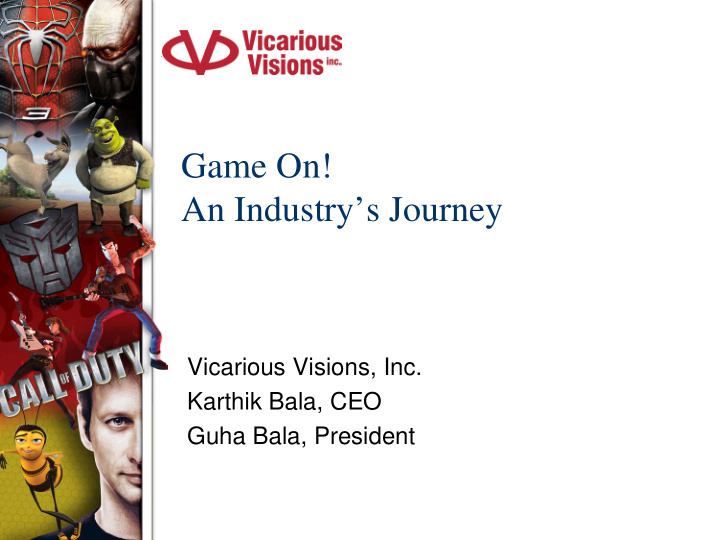



Game On! An Industry’s Journey Vicarious Visions, Inc. Karthik Bala, CEO Guha Bala, President
About Vicarious Visions A Leading developer of video games – Headquartered in Albany, NY, with 140 employees – Founded in 1994 by brothers Guha Bala and Karthik Bala – In January 2005, VV was acquired by Activision, Inc. – the second largest publisher of video games in the world Market Success – 25 million games sold worldwide – Generated nearly $1 Billion in retail sales! Activision – Founded in 1979 – one of the first video game publishers – Annual sales over $1.5BB US 2
About Vicarious Visions Multi-platform Development – handheld and console – PlayStation 3, Xbox 360, Nintendo Wii – Nintendo DS, PlayStation Portable Strong Entertainment Brands & Partnerships – Shrek, Spider-Man, Star Wars, Transformers, Spongebob, Finding Nemo, Doom 3 and many others. – Dreamworks, Pixar, Disney, Lucasfilm, Sony Pictures, Marvel Our People – World class creative and technical talent – Diverse skill sets and backgrounds • Programmers, artists, writers, designers, musicians, producers • Recruited from around the world Our Code – ~20,000 lines of code in our games in 2000 – >1 Million lines of code in our games this year 3
Games have grown up Released in 1972 Simplistic games made from fundamentally few mechanics 4
Games have grown up This image cannot currently be displayed. 35 Years Later… 5
Niche to Mainstream This image cannot currently be displayed. 6
Games for every audience This image cannot currently be displayed. 7
Games are everywhere 8
The industry has grown up Cottage industry Large, specialized global businesses – Space Invaders • A single programmer • Distributed as a stand alone cabinets • Lines of code: ~400 lines of code; Data size: <10KB – Spider-Man Movie 3 • Team of ~300 (25% programmers, 40% artists, 20% designers, 5% audio, 10% production management) • 4+ million units distributed worldwide, with $25+MM consumer marketing spend • Lines of code: > 2 million; Data size: ~10 GB Hobbyist talent Specialized labor – Early games developed by simple teams of programmers and artists – Today, teams have more formally trained talent pool: programming and art training a must, and ongoing. Many have advanced degrees. Industry that generates $35BB in total worldwide sales. In the US, $16BB greater than movie box office receipts 9
Playing to win: success factors Great games that culturally resonate – Revenue and profits heavily correlate to top few titles – A fashion driven business Timing in the marketplace – Rigid market windows • Holiday: 60% of sales comes between October and December • Major movies releases • Shelf space and marketing committed much in advance Low defect rate • Handheld and console games cannot be patched • Games have rigorous standards for manufacturer approval A Talent Driven Business – Projects that offer creative and commercial impact – Quality workplace Sustainable delivery in this environment is very valuable 10
Opportunity knocks: 2002/2003 This image cannot currently be displayed. CNK opportunity – Another project slipped, $50MM hole in the forecast – Customer asked us to pull in the date by 1 year and add PS2 and X-Box – In retrospect a crazy decision Shipped on-time, Holiday 2003 to commerical success 11
Success paid for in blood Burnout Difficult work conditions Attrition Endemic to games industry 12
Opportunity to do better Spider-Man 2 for NDS – 5 months cycle – New technology – Hardware launch – Movie-tie in (DVD launch window) Better methodology better products, better quality of life – Software – Production Became the #2 title for the platform in 2004 big success 13
Method in our madness TSP/PSP – Initial rollout: PSP software training for programmers 2 1 week courses – External coaching for Spidey 2 NDS Capability training – Project management – Leadership development Upstream QA – Formation of early and mid stage QA effort 14
What’s worked Launches Team formation Quality owners Use of historical data for scoping 15
Challenges Planning techniques favor understood development methodology – Game development is iterative and values qualitative judgment of completion – Rework for purpose of polish increases game quality. Traditional TSP correlates rework with defects. • EV often confounded by iteration Training methodology tailored for programmers: we are in a software business, but the techniques need to be accessible for non-software people – Makes buy-in more challenging – Leads to lower participation in the technique Available tools are cumbersome for re-planning Result: Conclusions from data are inconclusive or inaccessible 16
Challenges External forces: – Licensors, subcontracts, other suppliers are not process compliant … so significant inputs are left outside the TSP process Our mistake: large scale change implemented without bulletproofing led to significant perception that process is burdensome 17
Replay: iterate and improve Tools: developing on the Dashboard Process: experimentation with SCRUM for early iterative prototyping. TSP for more structured development phase. Working on combining the techniques Training: adapting PSP training for broader audiences Staff support: relieving the tool and data manipulation burden from team members 18
Looking ahead… Lessons not just for games – Era of Digital Entertainment • Fusion of technology and creativity • Applicable to movie making, television, online, music - any form of digital media Talent pool is diverse, and huge Improvements will have far-reaching benefits 19
Our call to action … This image cannot currently be displayed. We’re broadening the reach of games … new experiences, new audiences - worldwide. The technology that’s drives this is growing ever more complex We must also broaden the way our project management methods engage technical and creative talent to achieve greater and sustainable success. 20
Recommend
More recommend